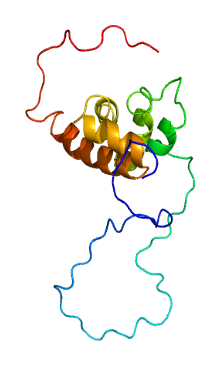
CASP8 and FADD-like apoptosis regulator is a protein that in humans is encoded by the CFLAR gene. Also called c-FLIP.

40S ribosomal protein S18 is a protein that in humans is encoded by the RPS18 gene.

Glutathione peroxidase 7 is an enzyme that in humans is encoded by the GPX7 gene.

EH-domain containing 2, also known as EHD2, is a human gene belonging to the EHD protein family.

High-mobility group protein B3 is a protein that in humans is encoded by the HMGB3 gene.

Synaptotagmin-7 is a protein that in humans is encoded by the SYT7 gene.

BTB/POZ domain-containing protein KCTD13 is a protein that in humans is encoded by the KCTD13 gene.

Proline-rich nuclear receptor coactivator 2 is a protein that in humans is encoded by the PNRC2 gene.

Ubiquitin-like protein 5 is a protein that in humans is encoded by the UBL5 gene.

Polyadenylate-binding protein 3 is a protein that in humans is encoded by the PABPC3 gene. PABPC3 is a member of a larger family of poly(A)-binding proteins in the human genome.

Cyclin-dependent kinase-like 2 is an enzyme that in humans is encoded by the CDKL2 gene.

39S ribosomal protein L10, mitochondrial is a protein that in humans is encoded by the MRPL10 gene.

60S ribosomal protein L10-like is a protein that in humans is encoded by the RPL10L gene.

Interleukin 34 (IL-34) is a protein belonging to a group of cytokines called interleukins. It was originally identified in humans, by large scale screening of secreted proteins; chimpanzee, murine, rat and chicken interleukin 34 orthologs have also been found. The protein is composed of 241 amino acids, 39 kilodaltons in mass, and forms homodimers. IL-34 increases growth or survival of immune cells known as monocytes; it elicits its activity by binding the Colony stimulating factor 1 receptor.

3-hydroxy-3-methylglutaryl-CoA synthase 2 (mitochondrial) is an enzyme in humans that is encoded by the HMGCS2 gene.

Calcium/calmodulin-dependent protein kinase ID is a protein in humans that is encoded by the CAMK1D gene on chromosome 10.

Adipocyte Enhancer-Binding Protein is a zinc finger protein that in humans is encoded by the evolutionarily well-conserved gene AEBP2. It was initially identified due to its binding capability to the promoter of the adipocyte P2 gene, and was therefore named Adipocyte Enhancer Binding Protein 2. AEBP2 is a potential targeting protein for the mammalian Polycomb Repression Complex 2 (PRC2).

Centrosomal protein 104kDa is a protein that in humans is encoded by the CEP104 gene. Like its Chlamydomonas ortholog, FAP256, it has been shown to localize to the distal ends of both centrioles in the absence of a cilium. During cilium formation, it is found at the tip of the elongating cilium.

Acyl-CoA thioesterase 1 is a protein that in humans is encoded by the ACOT1 gene.

Cysteine dioxygenase type 1 is a protein that in humans is encoded by the CDO1 gene.





















